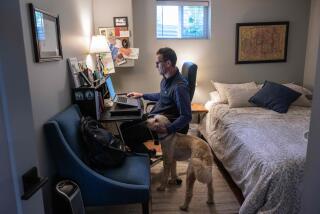Job Search by Videoconference: Face-to-Face and Cross-Country
- Share via
NEW YORK — After New Yorker Laura McCormick did well in a phone interview with an executive at Kinko’s Inc.’s headquarters in Ventura, she was invited to have a second interview--at Kinko’s videoconference center in Manhattan.
“It was very exciting,” McCormick recalled. “I could see the person I was speaking to on one video monitor and could see my own face on another, so I knew how I was coming across. The interview was at least an hour and a half, and I developed a personal rapport with the person, much more than over the phone.
“So when I came out to Ventura for my personal interview, I felt that the video meeting had given me a distinct advantage that I wouldn’t have had with just a phone conversation,” McCormick said.
McCormick got the job as public relations director for the 900-outlet office-support company, which also is a pioneer in providing business videoconferencing at 130 of its facilities.
During McCormick’s video interview three years ago, “there was a slight lag” between the time words were spoken at one end and received at the other, she said, “but that doesn’t exist anymore.”
*
Indeed, because videoconferencing technology can now deliver sounds and images with almost no delay in transmission, executive search companies are scrambling to install them in their offices.
“When doing a search, interviewing by video is often an expedient way of narrowing the prospect list to the best two or three, whom you would then arrange to interview personally,” said Paul Ray, president of Ray & Berndtson, a New York-based executive search firm.
“At the senior levels, it’s still face-to-face,” Ray said, “but it won’t be long before everybody has a laptop on their desk with videoconferencing capability.”
“Videoconferencing could revolutionize the recruitment of senior-level executives,” said Robert Rollo of Rollo Associates, a Los Angeles executive search firm.
“I have already found this year that I am traveling half as much and seeing twice as many CEOs and potential candidates because of videoconferencing,” he said.
Formerly, it took five months “to complete a senior-level executive search,” but now, Rollo said, videoconferencing “has helped to reduce our time to three months.”
Then there’s the monetary savings. Instead of flying to five countries to find a Latin American director for a major North American financial institution, “which would have taken me a week and cost my client about $15,000,” Rollo said, “we did it in 10 to 15 hours by videoconferencing for $3,000.”
“It’s helping us reduce the cost of our search dramatically,” agreed Bob Kenzer, CEO of recruiter Kenzer Corp. in New York.
“It costs $800 to fly to Chicago and you can have a videoconference for $200,” he said. “And it gives our client a bird’s-eye view of the candidate.”
*
Increasingly, Kenzer said, “anyone in the middle management level and above is being videoconferenced. The first interview might be telephonic but the second is videoconferencing. They either go to one of our offices, all of which have sophisticated videoconferencing equipment, or to a Kinko’s or to a hotel which is a videoconference provider.”
Fortune 500 companies now typically have videoconferencing facilities of their own, Kenzer said, “so there’s going to be more and more of this in the future.”
According to Kinko’s McCormick, “We’ve seen a steady increase in the use of our videoconferencing facilities by executive search firms in the last two years.”
“Some of them have their own facilities but use Kinko’s for overflow work, and it’s particularly handy for small and mid-sized firms that can’t afford the equipment.”
More to Read
Inside the business of entertainment
The Wide Shot brings you news, analysis and insights on everything from streaming wars to production — and what it all means for the future.
You may occasionally receive promotional content from the Los Angeles Times.










